VOLKSWAGEN TRANSPORTER 2012 Repair Manual
Manufacturer: VOLKSWAGEN, Model Year: 2012, Model line: TRANSPORTER, Model: VOLKSWAGEN TRANSPORTER 2012Pages: 486, PDF Size: 69.28 MB
Page 61 of 486
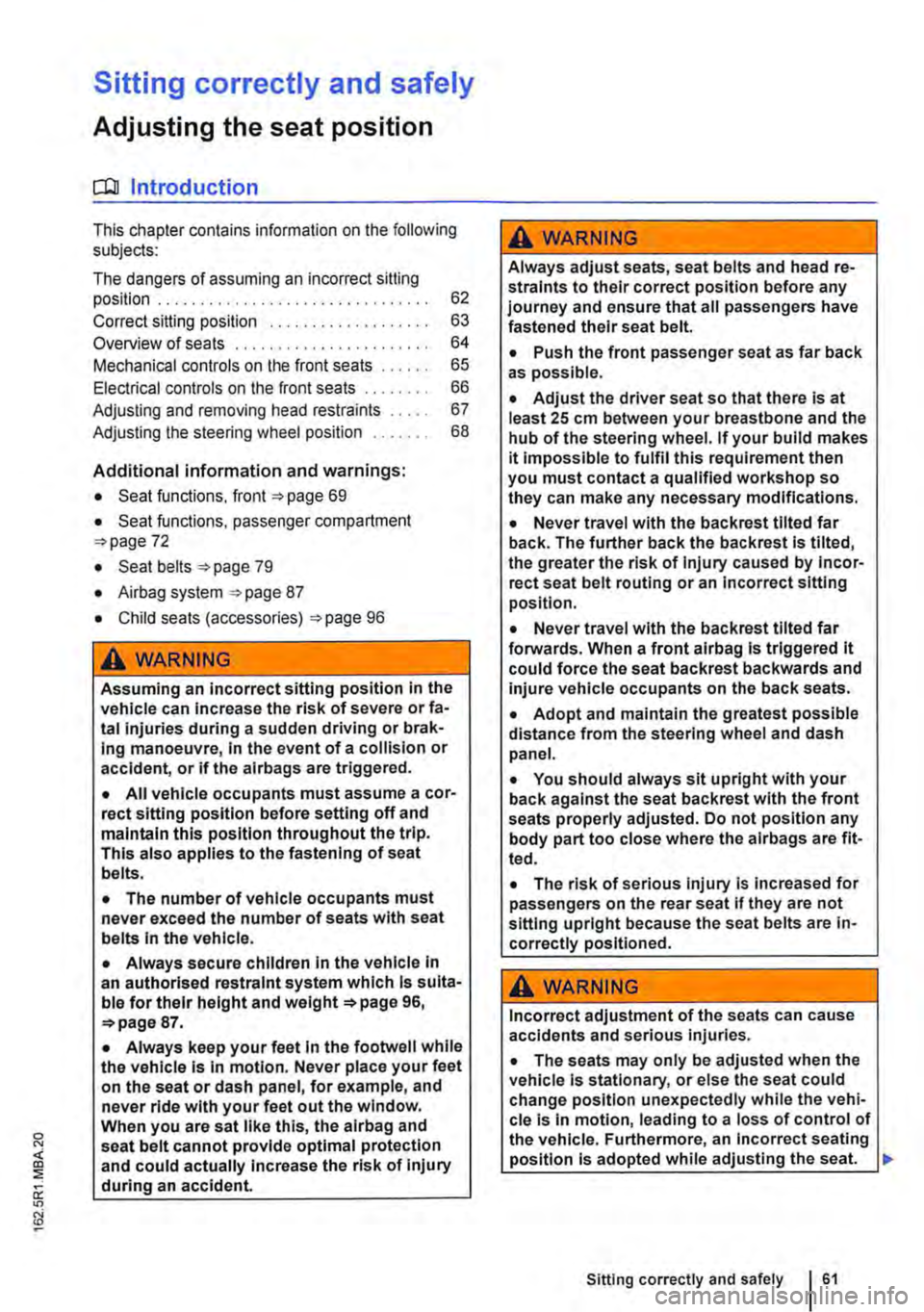
Sitting correctly and safely
Adjusting the seat position
COl Introduction
This chapter contains information on the following subjects:
The dangers of assuming an incorrect sitting position . . . .............. .
Correct sitting position . . . . . . ......... . Overview of seats ...................... .
Mechanical controls on the front seats ..... .
Electrical controls on the front seats ....... . Adjusting and removing head restraints .... .
Adjusting the steering wheel position ...... .
Additional information and warnings:
• Seat functions, front 69
• Seat functions, passenger compartment 72
• Seat belts 79
• Airbag system 87
• Child seats (accessories) 96
A WARNING
62
63
64
65
66
67
68
Assuming an incorrect sitting position in the vehicle can increase the risk of severe or fa-tal injuries during a sudden driving or brak-ing manoeuvre, in the event of a collision or accident, or if the airbags are triggered.
• All vehicle occupants must assume a cor-rect sitting position before setting off and maintain this position throughout the trip. This also applies to the fastening of seat belts.
• The number of vehicle occupants must never exceed the number of seats with seat belts in the vehicle.
• Always secure children in the vehicle in an authorised restraint system which Is suita-ble for their height and page 96, 87.
• Always keep your feet in the footweli while the vehicle is in motion. Never place your feet on the seat or dash panel, for example, and never ride with your feet out the window. When you are sat like this, the airbag and seat belt cannot provide optimal protection and could actually increase the risk of Injury during an accident.
A WARNING
Always adjust seats, seat belts and head re-straints to their correct position before any journey and ensure that ail passengers have fastened their seat belt.
• Push the front passenger seat as far back as possible.
• Adjust the driver seat so that there is at least 25 cm between your breastbone and the hub of the steering wheel. If your build makes it impossible to fulfil this requirement then you must contact a qualified workshop so they can make any necessary modifications.
• Never travel with the back rest tilted far back. The further back the backrest is tilted, the greater the risk of injury caused by incor-rect seat belt routing or an incorrect sitting position.
• Never travel with the back rest tilted far forwards. When a front airbag is triggered it could force the seat backrest backwards and injure vehicle occupants on the back seats.
• Adopt and maintain the greatest possible distance from the steering wheel and dash panel.
• You should always sit upright with your back against the seat back rest with the front seats properly adjusted. Do not position any body part too close where the airbags are fit-ted.
• The risk of serious injury Is increased for passengers on the rear seat if they are not sitting upright because the seat belts are in-correctly positioned.
A WARNING
Incorrect adjustment of the seats can cause accidents and serious injuries.
• The seats may only be adjusted when the vehicle is stationary, or else the seat could change position unexpectedly while the vehi-cle is in motion, leading to a loss of control of the vehicle. Furthermore, an incorrect seating position is adopted while adjusting the seat. .,.
Sitting correctly and safely 61
Page 62 of 486

A WARNING (Continued)
• Only adjust the height and tilt of the seat or move lt forwards and backwards when the area around the seat is clear.
• There should be no objects in the adjust-ment area of the front seats.
• Make sure that there is no dirt in the areas within which the front seats can be adjusted (and locked In place).
A WARNING
Cigarette lighters in the vehicle could be damaged or accidentally lit. This could lead to serious burns and other Injuries.
• Before adjusting the seats always make sure that there is no lighter on or near the moveable parts of the seat.
• Before closing stowage areas or compart-ments always ensure that there Is no lighter in the way.
• Never stow lighters in stowage areas or compartments or on other surfaces In the ve-hicle. Cigarette lighters may self-Ignite on high-temperature surfaces, especially In sum-
The dangers of assuming an incorrect sitting position
.....-m First read and observe the Introductory L-.bU information and safety warnings & on page 61.
If the seat belts are not worn or are worn incorrect-ly, the risk of severe or fatal injuries increases. Seat belts can only provide optimal protection if the seat belt routing is correct. Assuming an incorrect sitting position considerably impairs the level of protection provided by a seat belt. This could lead to severe or even fatal injuries. The risk of severe or fatal injuries is especially increased when a de-ploying airbag strikes a vehicle occupant who has assumed an incorrect sitting position. The driver is responsible for all occupants transported in the ve-hicle, especially children.
The following list contains examples of sitting posi-tions that can be dangerous for all vehicle occu-pants.
Whenever the vehicle is in motion:
• Never stand in the vehicle.
• Never stand on the seats.
• Never kneel on the seats.
• Never tilt the backrest too far to the rear.
• Never lean against the dash panel.
• Never lie on the seats in the passenger com-partment.
• Never sit on the front edge of a seat.
• Never sit sideways.
Before the journey
• Never lean out of a window .
• Never put your feet out of a window.
• Never put your feet on the dash panel.
• Never place your feet on the seat cushion or seat backrest.
• Never travel in a footwell.
• Never sit on the armrest.
• Never travel on a seat without wearing the seat belt.
• Never use the bed.
• Never travel in the luggage compartment or on the load surface.
A WARNING
Every Incorrect sitting position In the vehicle Increases the risk of severe or fatal Injuries In the event of an accident or sudden driving or braking manoeuvre.
• All vehicle occupants must maintain a cor-rect sitting position and wear their seat belt properly while the vehicle Is In motion.
• Sitting In an incorrect position, not fasten-ing the seat belt, or too short a distance to the alrbag exposes the occupants to critical or fatal injuries, especially if the alrbags de-ploy and strike an occupant who has as-sumed an Incorrect sitting position.
Page 63 of 486
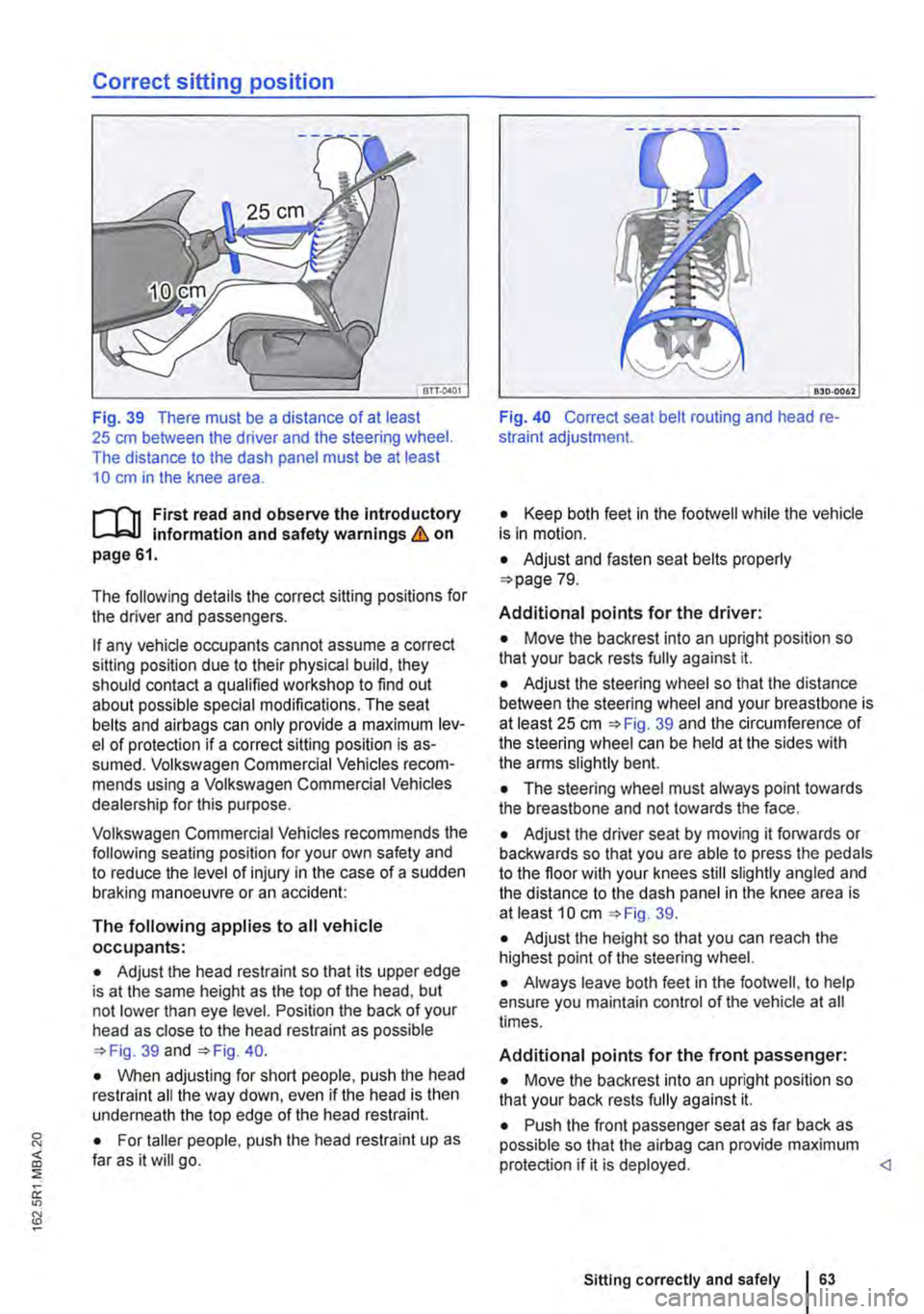
Correct sitting position
Fig. 39 There must be a distance of at least 25 cm between the driver and the steering wheel. The distance to the dash panel must be at least 10 cm in the knee area.
f"'"""('n First read and observe the introductory L-Jc..l.l Information and safety warnings & on page 61.
The following details the correct sitting positions for the driver and passengers.
If any vehicle occupants cannot assume a correct sitting position due to their physical build, they should contact a qualified workshop to find out about possible special modifications. The seat belts and airbags can only provide a maximum lev-el of protection if a correct sitting position is as-sumed. Volkswagen Commercial Vehicles recom-mends using a Volkswagen Commercial Vehicles dealership for this purpose.
Volkswagen Commercial Vehicles recommends the following seating position for your own safety and to reduce the level of injury in the case of a sudden braking manoeuvre or an accident:
The following applies to all vehicle occupants:
• Adjust the head restraint so that its upper edge is at the same height as the top of the head, but not lower than eye level. Position the back of your head as close to the head restraint as possible 39 and 40.
• When adjusting for short people, push the head restraint all the way down, even if the head is then underneath the top edge of the head restraint.
• For taller people, push the head restraint up as far as it will go.
Fig. 40 Correct seat belt routing and head re-straint adjustment.
• Keep both feet in the footwell while the vehicle is in motion.
• Adjust and fasten seat belts properly 79.
Additional points for the driver:
• Move the backrest into an upright position so that your back rests fully against it.
• Adjust the steering wheel so that the distance between the steering wheel and your breastbone is at least 25 cm 39 and the circumference of the steering wheel can be held at the sides with the arms slightly bent.
• The steering wheel must always point towards the breastbone and not towards the face.
• Adjust the driver seat by moving it forwards or backwards so that you are able to press the pedals to the floor with your knees still slightly angled and the distance to the dash panel in the knee area is at least 10 cm 39.
• Adjust the height so that you can reach the highest point of the steering wheel.
• Always leave both feet in the footwell, to help ensure you maintain control of the vehicle at all times.
Additional points for the front passenger:
• Move the backrest into an upright position so that your back rests fully against it.
• Push the front passenger seat as far back as possible so that the airbag can provide maximum protection if it is deployed.
Page 64 of 486
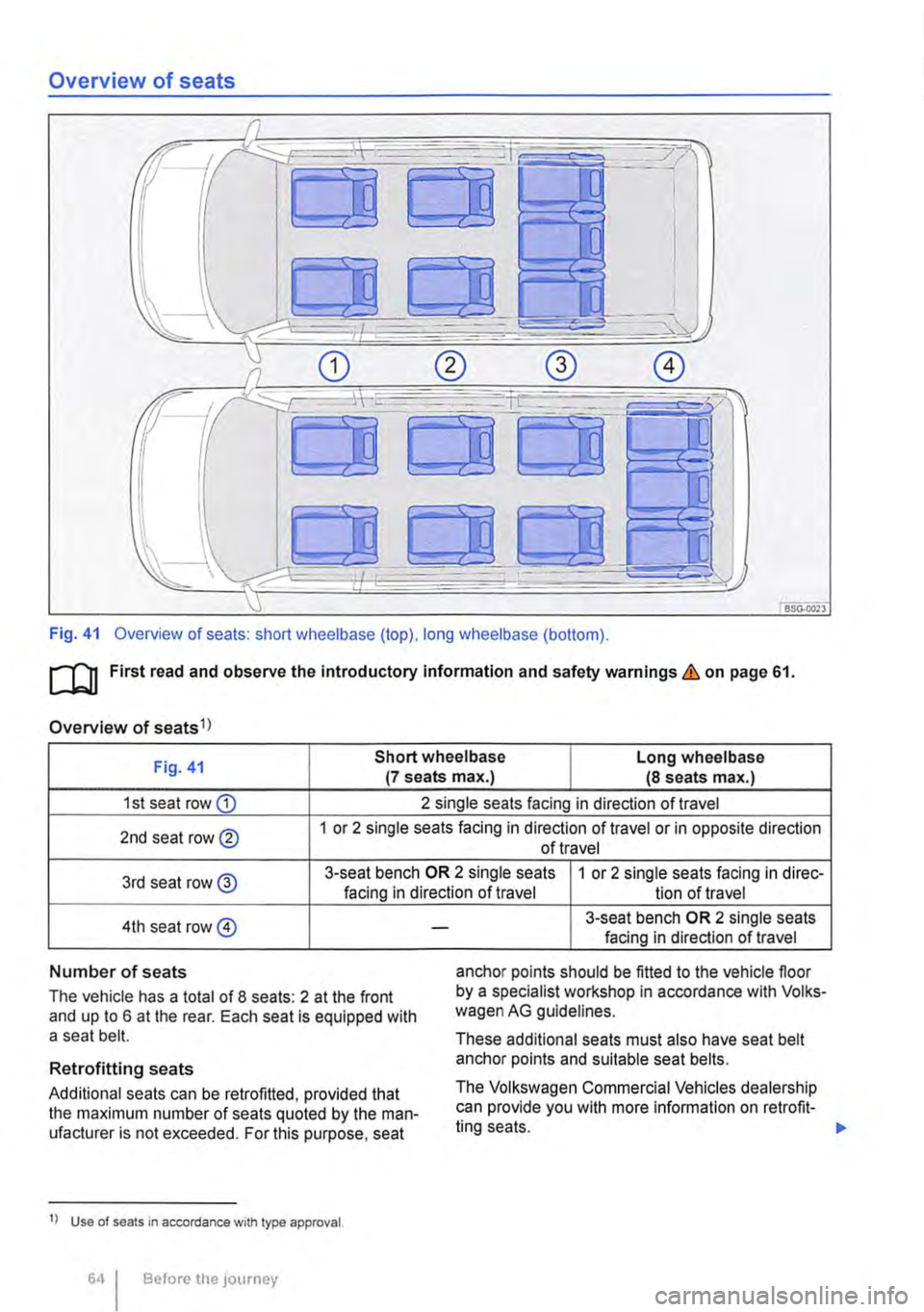
Overview of seats
Fig. 41 Overview of seats: short wheelbase (top), long wheelbase (bottom).
ro First read and observe the Introductory Information and safety warnings & on page 61.
Overview of seats 1)
Fig. 41 Short wheelbase Long wheelbase (7 seats max.) (8 seats max.)
1st seat row CD 2 single seats facing in direction of travel
2nd seat row® 1 or 2 single seats facing in direction of travel or in opposite direction of travel
3rd seat row 0 3-seat bench OR 2 single seats 1 or 2 single seats facing in direc-facing in direction of travel lion of travel
4th seat row @
Number of seats
The vehicle has a total of 8 seats: 2 at the front and up to 6 at the rear. Each seat is equipped with a seat belt.
Retrofitting seats
Additional seats can be retrofitted, provided that the maximum number of seats quoted by the man-ufacturer is not exceeded. For this purpose, seat
1> Use of seats 1n accordance with type approval.
Before the journey
-3-seat bench OR 2 single seats facing in direction of travel
anchor points should be fitted to the vehicle floor by a specialist workshop in accordance with Volks-wagen AG guidelines.
These additional seats must also have seat belt anchor points and suitable seat belts.
The Volkswagen Commercial Vehicles dealership can provide you with more information on retrofit-ting seats. .,.
Page 65 of 486
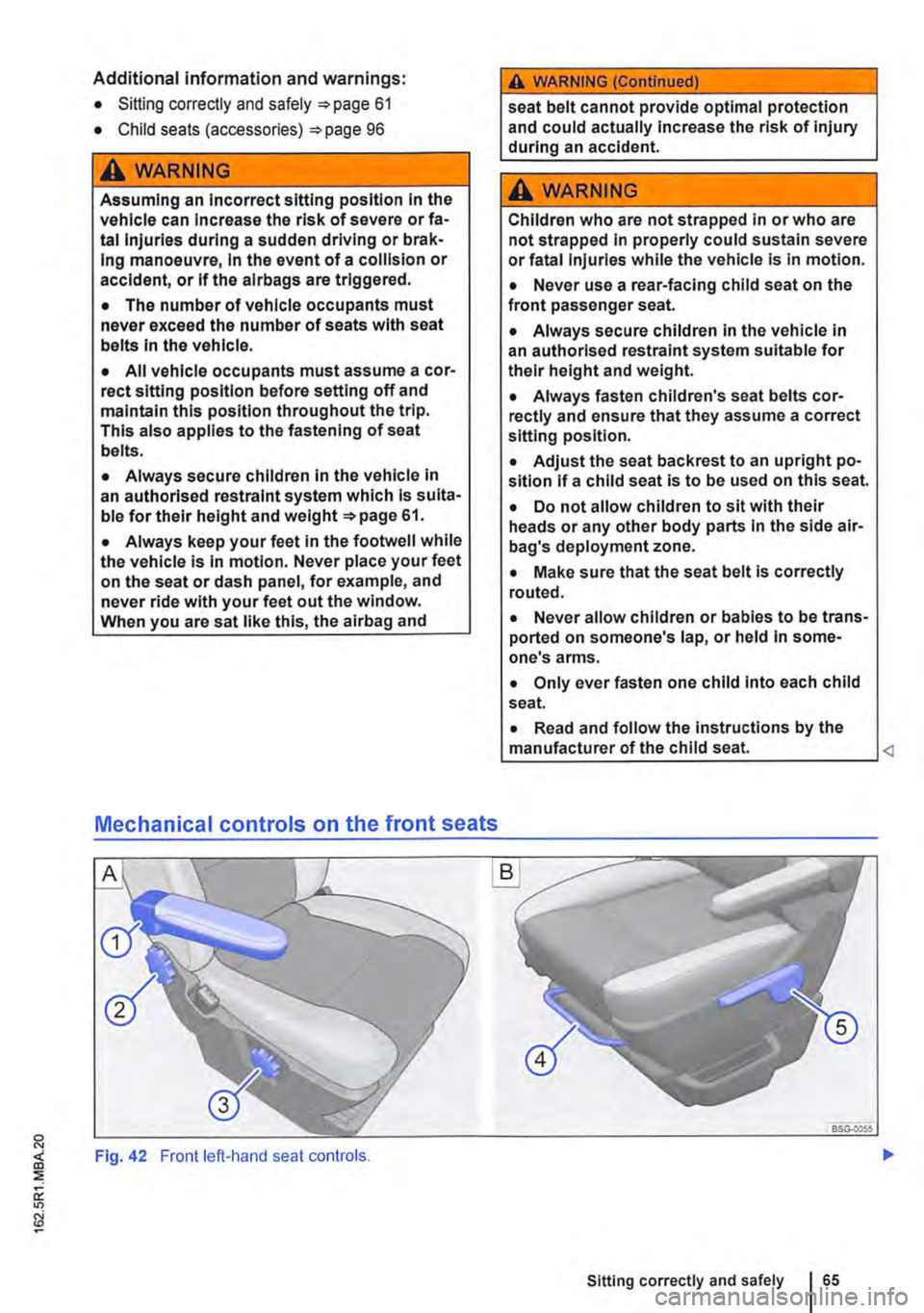
Additional information and warnings:
• Sitting correctly and safely 61
• Child seats (accessories) 96
A WARNING
Assuming an Incorrect sitting position In the vehicle can Increase the risk of severe or fa-tal injuries during a sudden driving or brak-Ing manoeuvre, In the event of a collision or accident, or If the alrbags are triggered.
• The number of vehicle occupants must never exceed the number of seats with seat belts In the vehicle.
• All vehicle occupants must assume a cor-rect sitting position before setting off and maintain this position throughout the trip. This also applies to the fastening of seat belts.
• Always secure children in the vehicle in an authorised restraint system which is suita-ble for their height and page 61.
• Always keep your feet in the footwell while the vehicle is in motion. Never place your feet on the seat or dash panel, for example, and never ride with your feet out the window. When you are sat like this, the airbag and
Mechanical controls on the front seats
Fig. 42 Front left-hand seat controls.
A WARNING (Continued)
seat belt cannot provide optimal protection and could actually increase the risk of injury during an accident.
A WARNING
Children who are not strapped in or who are not strapped in properly could sustain severe or fatal Injuries while the vehicle Is In motion.
• Never use a rear-facing child seat on the front passenger seat.
• Always secure children in the vehicle in an authorised restraint system suitable for their height and weight.
• Always fasten children's seat belts cor-rectly and ensure that they assume a correct sitting position.
• Adjust the seat backrest to an upright po-sition If a child seat is to be used on this seat.
• Do not allow children to sit with their heads or any other body parts in the side air-bag's deployment zone.
• Make sure that the seat belt is correctly routed.
• Never allow children or babies to be trans-ported on someone's lap, or held in some-one's arms.
• Only ever fasten one child Into each child seat.
• Read and follow the instructions by the manufacturer of the child seat.
Page 66 of 486
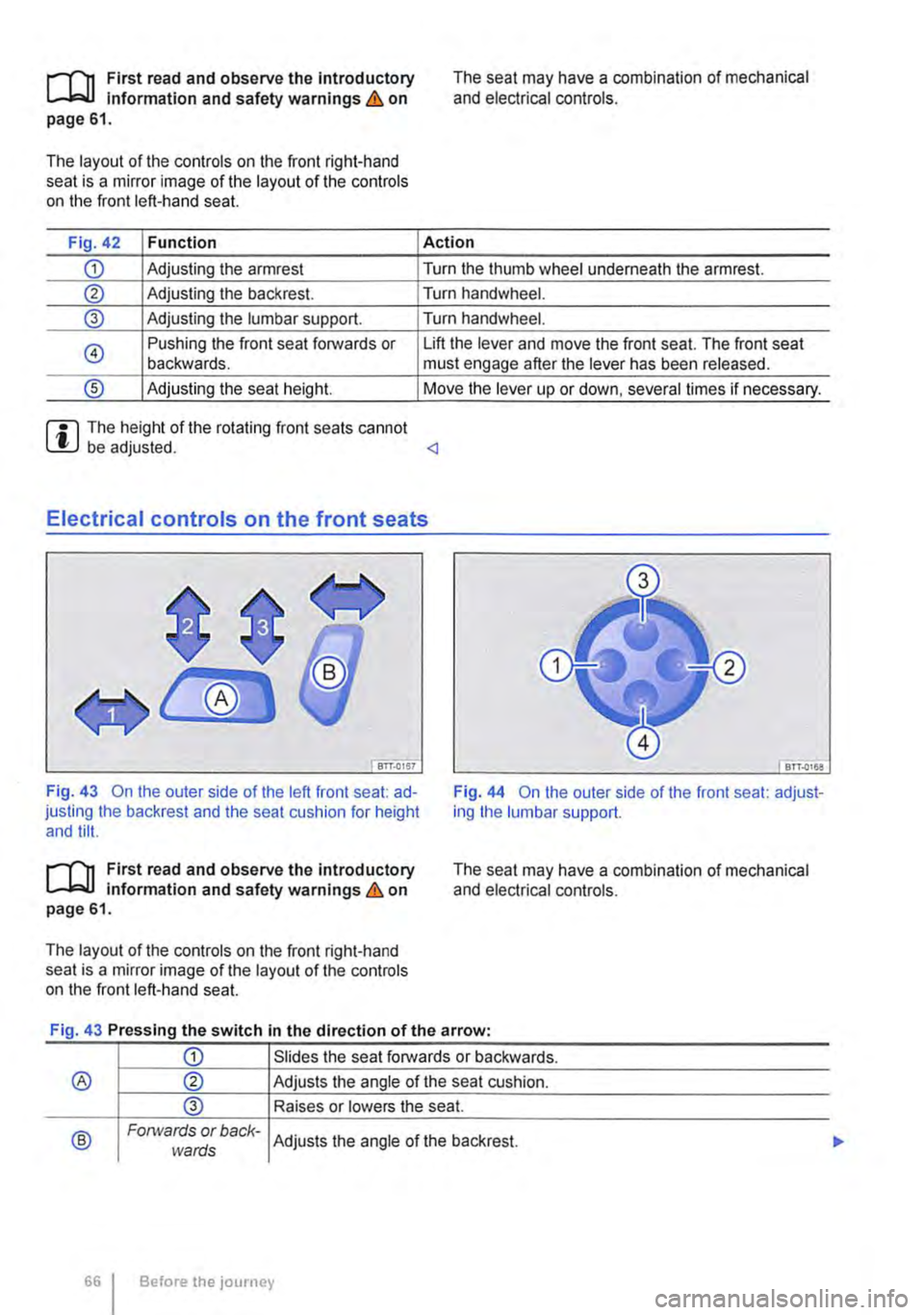
r-f'n First read and observe the introductory Information and safety warnings & on page 61.
The layout of the controls on the front right-hand seat is a mirror image of the layout of the controls on the front left-hand seat.
Fig. 42 Function
G) Adjusting the armrest
® Adjusting the backrest.
@) Adjusting the lumbar support.
0 Pushing the front seat forwards or backwards.
® Adjusting the seat height.
The seat may have a combination of mechanical and electrical controls.
Action
Turn the thumb wheel underneath the armrest.
Turn handwheel.
Turn handwheel.
Lift the lever and move the front seat. The front seat must engage after the lever has been released.
Move the lever up or down. several times if necessary.
m The height of the rotating front seats cannot L!J be adjusted.
BTT.0168
Fig. 43 On the outer side of the left front seat: ad-justing the backrest and the seat cushion for height and tilt.
Fig. 44 On the outer side of the front seat: adjust-ing the lumbar support.
r-f'n First read and observe the introductory information and safety warnings & on page 61.
The layout of the controls on the front right-hand seat is a mirror image of the layout of the controls on the front left-hand seat.
The seat may have a combination of mechanical and electrical controls.
Fig 43 Pressing the switch in the direction of the arrow·
G) Slides the seat forwards or backwards.
® ® Adjusts the angle of the seat cushion.
@) Raises or lowers the seat.
® Forwards or back-Adjusts the angle of the backrest. wards
Before the journey
Page 67 of 486
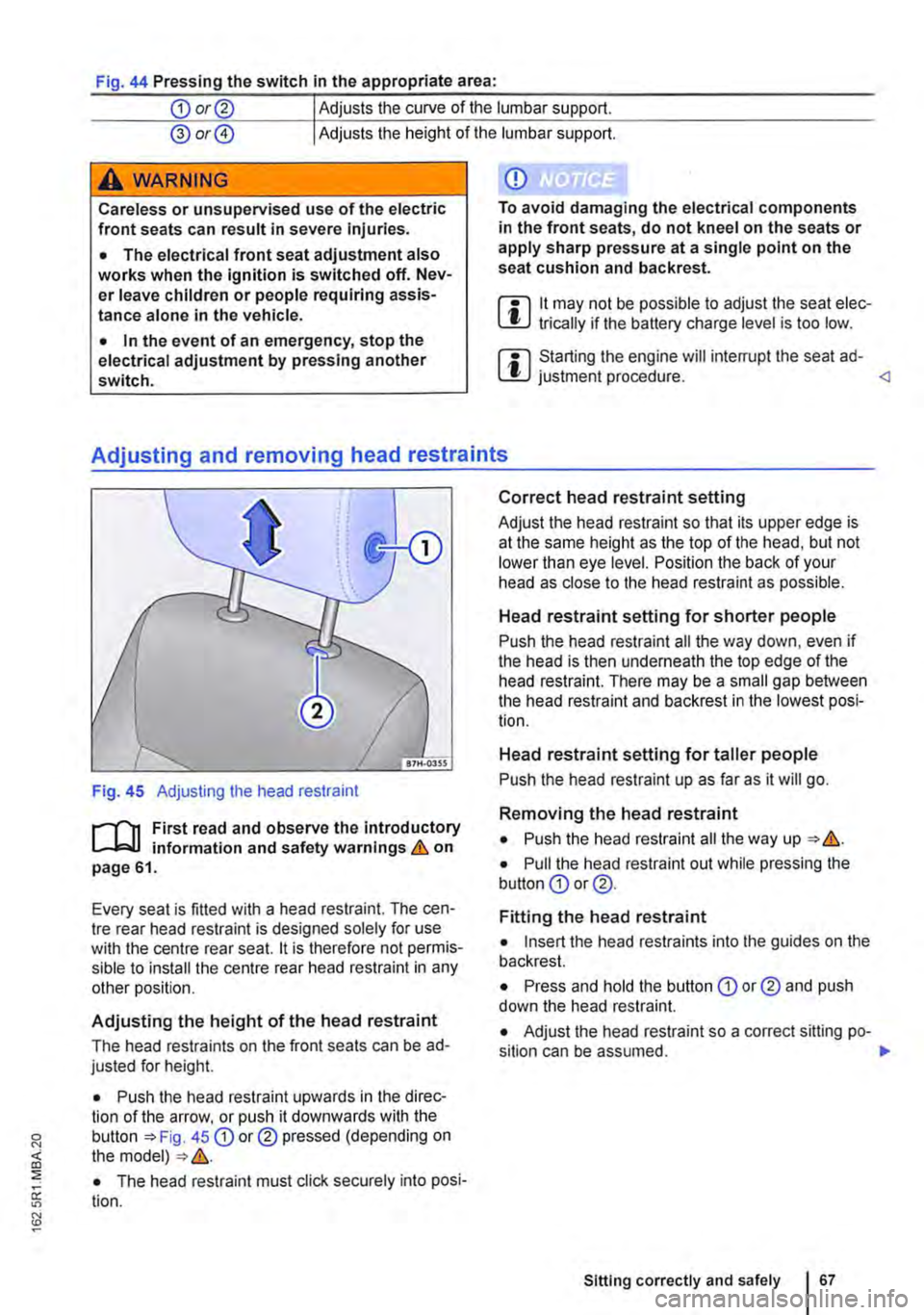
Fig. 44 Pressing the switch In the appropriate area:
CD or@ Adjusts the curve of the lumbar support.
@ or@ Adjusts the height of the lumbar support.
A wARNING
Careless or unsupervised use of the electric front seats can result in severe Injuries.
• The electrical front seat adjustment also works when the ignition is switched off. Nev-er leave children or people requiring assis-tance alone in the vehicle.
• In the event of an emergency, stop the electrical adjustment by pressing another switch.
CD
To avoid damaging the electrical components in the front seats, do not kneel on the seats or apply sharp pressure at a single point on the seat cushion and backrest.
m 11 may not be possible to adjust the seat elec-l!J trically if the battery charge level is too low.
m Starting the engine will interrupt the seat ad-l!J justment procedure.
Fig. 45 Adjusting the head restraint
r--("'n First read and observe the introductory L--J,::.U information and safety warnings & on page 61.
Every seat is fitted with a head restraint. The cen-tre rear head restraint is designed solely for use with the centre rear seat. 11 is therefore not permis-sible to install the centre rear head restraint in any other position.
Adjusting the height of the head restraint
The head restraints on the front seats can be ad-justed for height.
• Push the head restraint upwards in the direc-tion of the arrow, or push it downwards with the button 45 CD or® pressed (depending on the model) &.
• The head restraint must click securely into posi-tion.
Correct head restraint setting
Adjust the head restraint so that its upper edge is at the same height as the top of the head, but not lower than eye level. Position the back of your head as close to the head restraint as possible.
Head restraint setting for shorter people
Push the head restraint all the way down, even if the head is then underneath the top edge of the head restraint. There may be a small gap between the head restraint and backrest in the lowest posi-tion.
Head restraint setting for taller people
Push the head restraint up as far as it will go.
Removing the head restraint
• Push the head restraint all the way up &.
• Pull the head restraint out while pressing the button CD or @.
Fitting the head restraint
• Insert the head restraints into the guides on the backrest.
• Press and hold the button CD or® and push down the head restraint.
• Adjust the head restraint so a correct sitting po-sition can be assumed. .,.
Sitting correctly and safely 167
Page 68 of 486
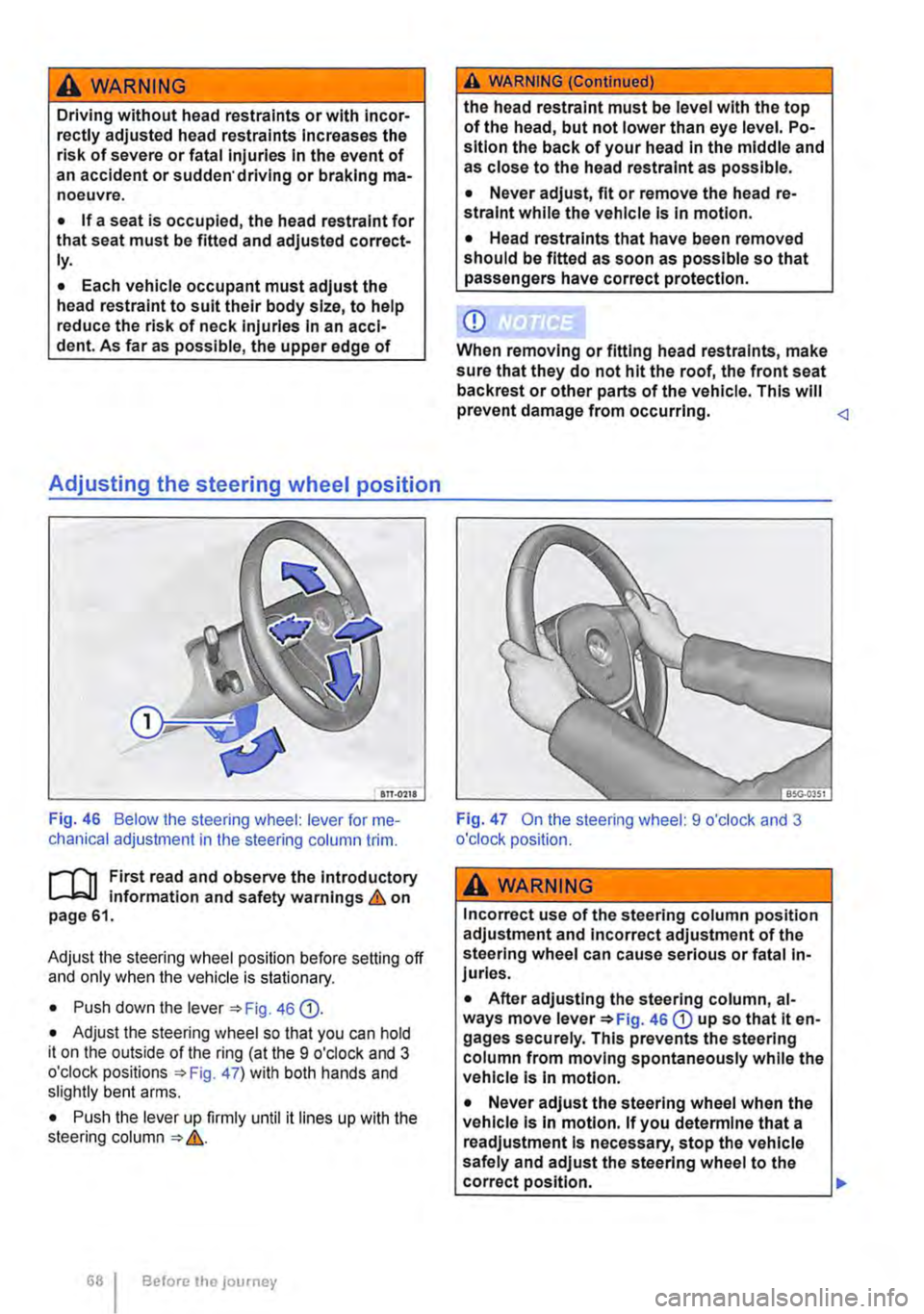
A WARNING
Driving without head restraints or with Incor-rectly adjusted head restraints Increases the risk of severe or fatal injuries In the event of an accident or sudden' driving or braking ma-noeuvre.
• If a seat is occupied, the head restraint for that seat must be fitted and adjusted correct-ly.
• Each vehicle occupant must adjust the head restraint to suit their body size, to help reduce the risk of neck injuries in an acci-dent. As far as possible, the upper edge of
Adjusting the steering wheel position
an-0211
Fig. 46 Below the steering wheel: lever for me-chanical adjustment in the steering column trim.
r--f'n First read and observe the introductory L-W.I information and safety warnings & on page 61.
Adjust the steering wheel position before setting off and only when the vehicle is stationary.
• Push down the lever 46 Q).
• Adjust the steering wheel so that you can hold it on the outside of the ring (at the 9 o'clock and 3 o'clock positions =:o Fig. 47) with both hands and slightly bent arms.
• Push the lever up firmly until it lines up with the steering column =:o &.
Before the journey
A WARNING (Continued)
the head restraint must be level with the top of the head, but not lower than eye level. Po-sition the back of your head in the middle and as close to the head restraint as possible.
• Never adjust, fit or remove the head re-straint while the vehicle is in motion.
• Head restraints that have been removed should be fitted as soon as possible so that passengers have correct protection.
CD
When removing or fitting head restraints, make sure that they do not hit the roof, the front seat back rest or other parts of the vehicle. This will prevent damage from occurring.
A WARNING
Incorrect use of the steering column position adjustment and Incorrect adjustment of the steering wheel can cause serious or fatal In-juries.
• After adjusting the steering column, al-ways move lever =:oFig. 46 CD up so that it en-gages securely. This prevents the steering column from moving spontaneously while the vehicle Is In motion.
• Never adjust the steering wheel when the vehicle Is In motion. If you determine that a readjustment Is necessary, stop the vehicle safely and adjust the steering wheel to the correct position. .,.
Page 69 of 486
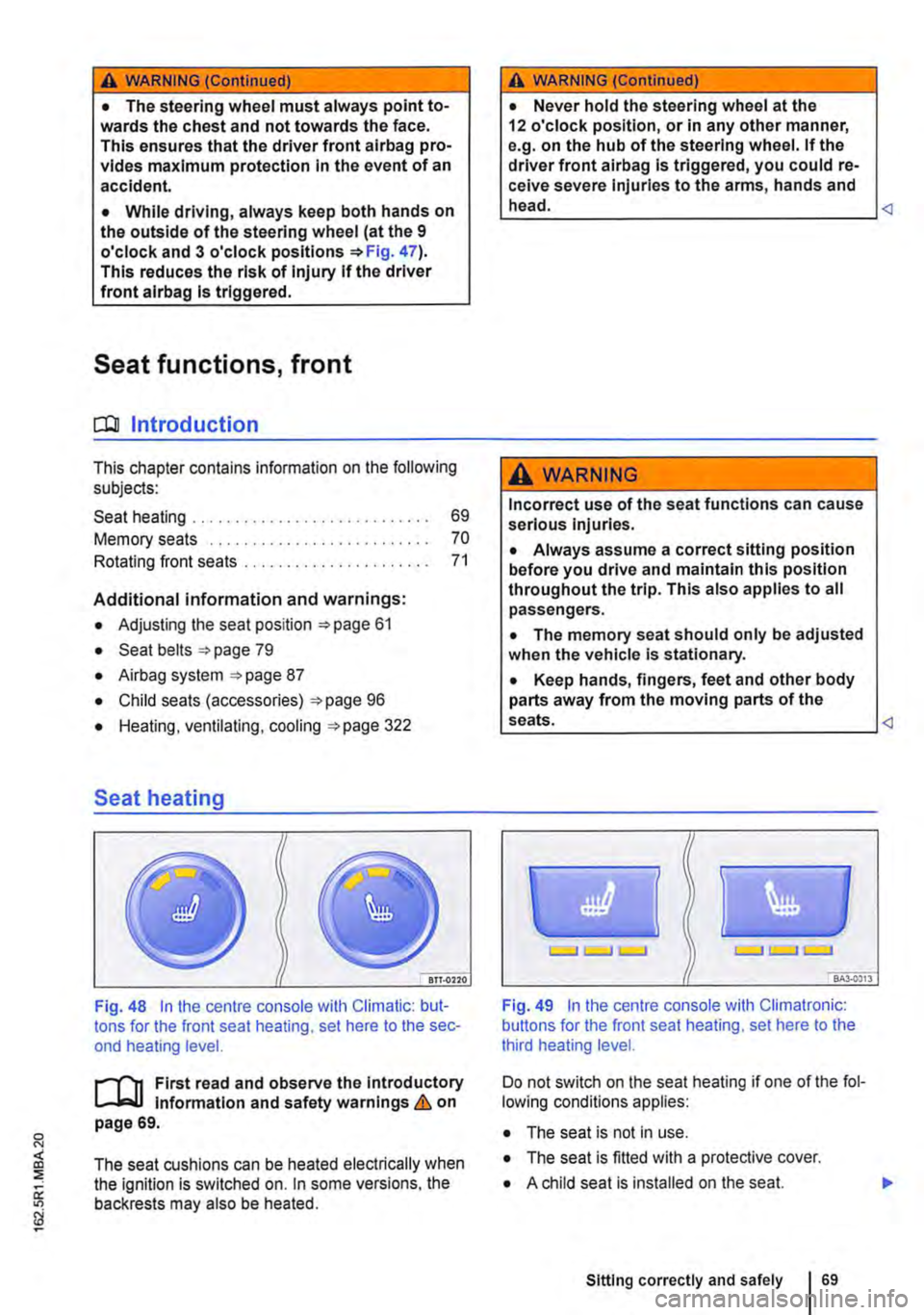
A WARNING (Continued)
• The steering wheel must always point to-wards the chest and not towards the face. This ensures that the driver front airbag pro-vides maximum protection in the event of an accident.
• While driving, always keep both hands on the outside of the steering wheel (at the 9 o'clock and 3 o'clock positions =>Fig. 47). This reduces the risk of injury if the driver front alrbag Is triggered.
Seat functions, front
a:n Introduction
This chapter contains information on the following subjects:
Seat heating . . . . . . . . . . . . . . . . . . . • • • . . . . . . 69
Memory seats . . . . . . . . . . . . . . . . . . . 70
Rotating front seats . . . . . . . . . . . . . . . . . . . . . . 71
Additional information and warnings:
• Adjusting the seat position =>page 61
• Seat bells =>page 79
• Airbag system =>page 87
• Child seats (accessories) 96
• Heating, ventilating, cooling 322
Seat heating
Fig. 48 In the centre console with Climatic: but-tons for the front seat heating, set here to the sec-ond heating level.
First read and observe the Introductory l-J,:.,U Information and safety warnings & on page 69.
The seat cushions can be heated electrically when the ignition is switched on. In some versions, the backrests may also be heated.
A WARNING (Continued)
• Never hold the steering wheel at the 12 o'clock position, or in any other manner, e.g. on the hub of the steering wheel. If the driver front airbag is triggered, you could re-ceive severe Injuries to the arms, hands and head.
A WARNING
Incorrect use of the seat functions can cause serious injuries.
• Always assume a correct sitting position before you drive and maintain this position throughout the trip. This also applies to all passengers.
• The memory seat should only be adjusted when the vehicle Is stationary.
• Keep hands, fingers, feet and other body parts away from the moving parts of the seats.
Fig. 49 In the centre console with Climatronic: buttons for the front seat heating, set here to the third heating level.
Do not switch on the seat heating if one of the fol-lowing conditions applies:
• The seat is not in use.
• The seat is fitted with a protective cover.
• A child seat is installed on the seat.
Sitting correctly and safely 69
Page 70 of 486
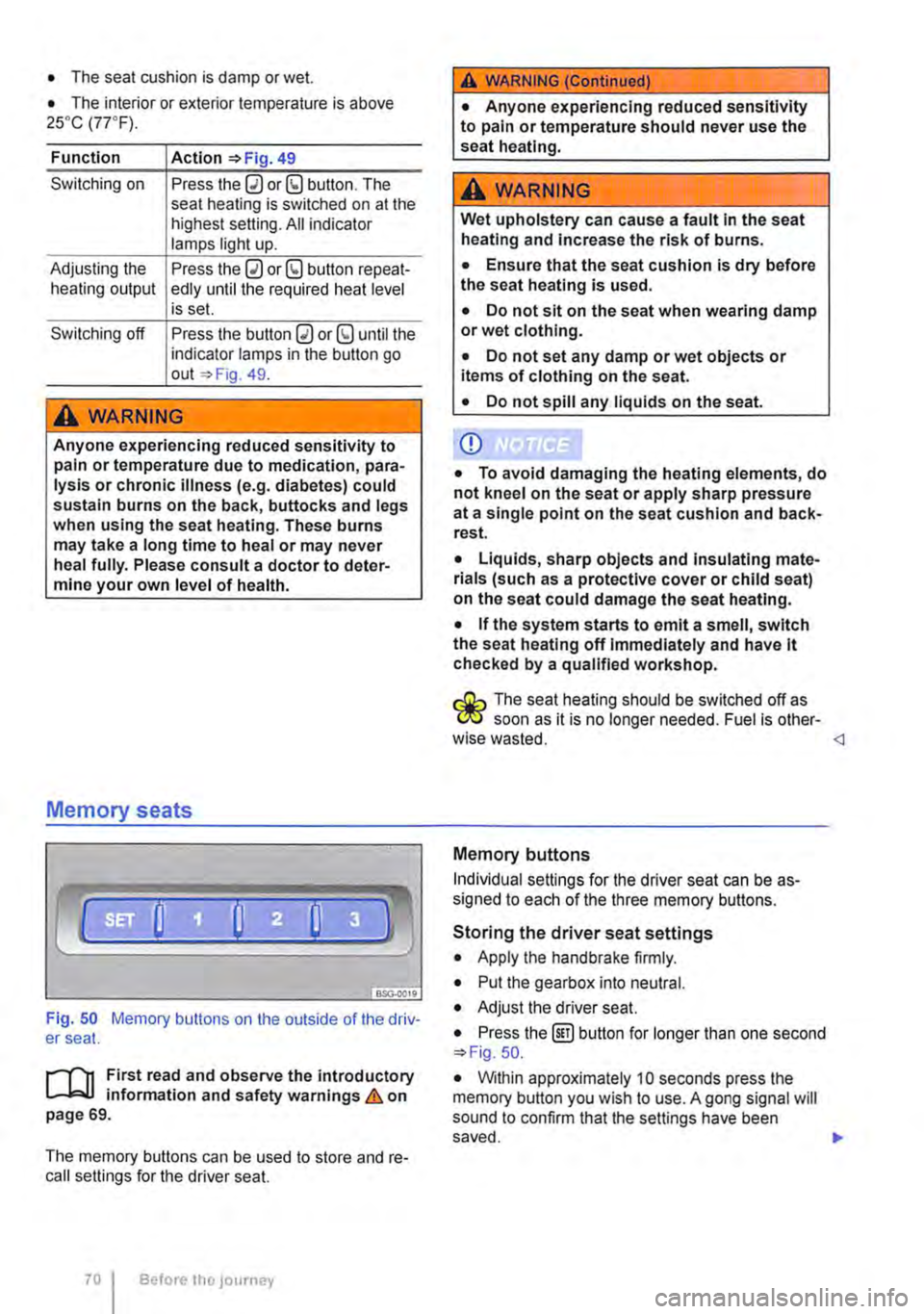
• The seat cushion is damp or wet.
• The interior or exterior temperature is above 2s•c (7rF).
Function
Switching on
Adjusting the heating output
Switching off
Action 49
Press the 0 or (9 button. The seat heating is switched on at the highest setting. All indicator lamps light up.
Press the 0 or (9 button repeat-edly until the required heat level is set.
Press the button 0 or (9 until the indicator lamps in the button go out 49.
A WARNING
Anyone experiencing reduced sensitivity to pain or temperature due to medication, para-lysis or chronic illness (e.g. diabetes) could sustain burns on the back, buttocks and legs when using the seat heating. These burns may take a long time to heal or may never heal fully. Please consult a doctor to deter-mine your own level of health.
Memory seats
Fig. 50 Memory buttons on the outside of the driv-er seat.
r"''l1 First read and observe the introductory L-JcJ.I information and safety warnings & on page 69.
The memory buttons can be used to store and re-call settings for the driver seat.
Before the JOurney
A WARNING (Continued)
• Anyone experiencing reduced sensitivity to pain or temperature should never use the seat heating.
A wARNING
Wet upholstery can cause a fault In the seat heating and Increase the risk of burns.
• Ensure that the seat cushion is dry before the seat heating is used.
• Do not sit on the seat when wearing damp or wet clothing.
• Do not set any damp or wet objects or items of clothing on the seat.
• Do not spill any liquids on the seat.
Q)
• To avoid damaging the heating elements, do not kneel on the seat or apply sharp pressure at a single point on the seat cushion and back-rest.
• Liquids, sharp objects and Insulating mate-rials (such as a protective cover or child seat) on the seat could damage the seat heating.
• If the system starts to emit a smell, switch the seat heating off Immediately and have lt checked by a qualified workshop.
r:O:-, The seat heating should be switched off as C!JtJ soon as it is no longer needed. Fuel is other-wise wasted.
Individual settings for the driver seat can be as-signed to each of the three memory buttons.
Storing the driver seat settings
• Apply the handbrake firmly.
• Put the gearbox into neutral.
• Adjust the driver seat.
• Press the @] button for longer than one second 50.
• Within approximately 10 seconds press the memory button you wish to use. A gong signal will sound to confirm that the settings have been saved. .,..